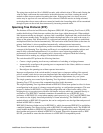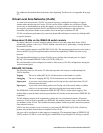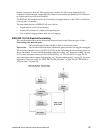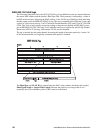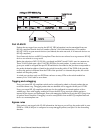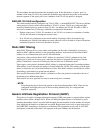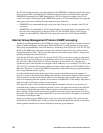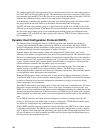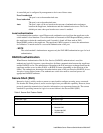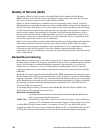Intel® Blade Server Ethernet Switch Module IXM5414E 33
Group addresses are stored in the Multicast Forwarding Database (MFDB). An IGMP address will be
removed from the database if a report for it is not received within the query interval. An interface may be
removed from an IGMP group in response to an IGMP Leave Group message.
Link aggregation
(LAG)
The Intel® Blade Server Ethernet Switch Module IXM5414E supports Link Aggregation (LAG), or
port trunking. Port trunks (aggregated ports) can be used to increase the bandwidth of a network
connection or to ensure fault recovery.You can configure up to two trunk connections (combining
two to four ports into one fat pipe) between any two SB-HEs or other Layer 2 switches. However,
before making any physical connections between devices, use the Link Aggregation commands to
specify the ports that will belong to the trunking group on both switches.
When using a port trunk, note that:
• The ports used in a trunk must all be of the same speed (100 Mbps or 1000 Mbps) and operate in
full-duplex mode only.
• The ports that can be assigned to the same trunk have certain other restrictions, as described in
this section.
• Each port can only be assigned to one trunk group, whether a static or dynamic group.
• The ports at both ends of a connection must be configured as trunk ports.
• All of the ports in a trunk have to be treated as a whole when moved from/to, added, or deleted
from a VLAN.
• The Spanning Tree Protocol (STP) will treat all the ports in a trunk as a whole.
• Enable the trunk before connecting any cable between the switches to avoid creating a data loop.
• Disconnect all trunk port cables or disable the trunk ports before removing a port trunk to avoid
creating a data loop.
Trunking can be set as a static or a dynamic port/group using the IEEE 802.3ad Link Aggregation
commands. When trunking is enabled, a blue border will be placed around the ports on the Web
device panel display.
Static LAGs
When you create a LAG, the member links will attempt to exchange LACPDUs with their partners.
If a link does not receive a LACPDU within 3 seconds, it will come up with default values. If a
LACPU is later received with different values, the link will drop out of the LAG. When all member
links have dropped out, the LAG will reconfigure itself with the new values from the received
LACPDUs.
It is important that when you configure LAGs, you should configure the LAGs and enable STP on
both partner devices before connecting the cables.
Distribution method
Link aggregation, or port trunking, enables several ports to be grouped together and to act as a single
link. This gives a bandwidth that is a multiple of a single-link bandwidth.
Port trunking is most commonly used to link a bandwidth intensive network device or devices, such
as a server, to the backbone of a network.



